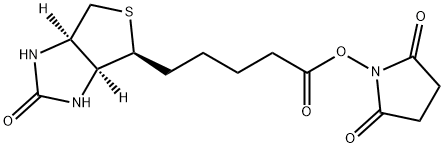BIOTINAMIDOHEXANOIC ACID 3-SULFO-N-HYDROXYSUCCINIMIDE ESTER SODIUM SALT
Synonym(s):Sulfosuccinimidyl 6-(biotinamido)hexanoate
- CAS NO.:191671-46-2
- Empirical Formula: C20H31N4NaO9S2
- Molecular Weight: 558.6
- MDL number: MFCD00078534
- SAFETY DATA SHEET (SDS)
- Update Date: 2024-11-19 23:02:33

What is BIOTINAMIDOHEXANOIC ACID 3-SULFO-N-HYDROXYSUCCINIMIDE ESTER SODIUM SALT?
Description
Sulfo-NHS-LC-Biotin is a linker containing a sulfo-NHS group and a biotin moiety. Sulfo-NHS enables control and modification of carbodiimide crosslinking reactions involving activation of carboxylates for conjugation with primary amines. The biotinylation can react with amine molecules in the presence of activator EDC or HATU.
Chemical properties
White Solid
The Uses of BIOTINAMIDOHEXANOIC ACID 3-SULFO-N-HYDROXYSUCCINIMIDE ESTER SODIUM SALT
Biotinamidohexanoic Acid 3-Sulfo-N-Hydroxysuccinimide Ester Sodium Salt has been used to biotinylate both the antibody and the carrier in the Protein Avidin-Biotin solid surfaces, such as plastics, which may reduce antigenicity. It has also been used to enhance the detection of DNA on nitrocellulose. Spacer Arm: 22.4 Ang
The Uses of BIOTINAMIDOHEXANOIC ACID 3-SULFO-N-HYDROXYSUCCINIMIDE ESTER SODIUM SALT
Has been used to biotinylate both the antibody and the carrier in the Protein Avidin-Biotin solid surfaces, such as plastics, which may reduce antigenicity. It has also been used to enhance the detection of DNA on nitrocellulose. Spacer Arm: 22.4 Angstroms
storage
Store at -20°C
Properties of BIOTINAMIDOHEXANOIC ACID 3-SULFO-N-HYDROXYSUCCINIMIDE ESTER SODIUM SALT
| Melting point: | >118°C (dec.) |
| storage temp. | Hygroscopic, -20°C Freezer, Under inert atmosphere |
| solubility | DMSO (Slightly), Methanol (Slightly) |
| form | Solid |
| color | White |
Safety information for BIOTINAMIDOHEXANOIC ACID 3-SULFO-N-HYDROXYSUCCINIMIDE ESTER SODIUM SALT
| Signal word | Danger |
| Pictogram(s) |
 Corrosion Corrosives GHS05 |
| GHS Hazard Statements |
H290:Corrosive to Metals H314:Skin corrosion/irritation |
| Precautionary Statement Codes |
P234:Keep only in original container. P260:Do not breathe dust/fume/gas/mist/vapours/spray. P264:Wash hands thoroughly after handling. P264:Wash skin thouroughly after handling. P280:Wear protective gloves/protective clothing/eye protection/face protection. P363:Wash contaminated clothing before reuse. P390:Absorb spillage to prevent material damage. P301+P330+P331:IF SWALLOWED: Rinse mouth. Do NOT induce vomiting. P303+P361+P353:IF ON SKIN (or hair): Remove/Take off Immediately all contaminated clothing. Rinse SKIN with water/shower. P405:Store locked up. P406:Store in corrosive resistant/… container with a resistant inner liner. |
Computed Descriptors for BIOTINAMIDOHEXANOIC ACID 3-SULFO-N-HYDROXYSUCCINIMIDE ESTER SODIUM SALT
New Products
Tert-butyl bis(2-chloroethyl)carbamate 4-Methylphenylacetic acid N-Boc-D-alaninol N-BOC-D/L-ALANINOL N-octanoyl benzotriazole 3-Morpholino-1-(4-nitrophenyl)-5,6-dihydropyridin- 2(1H)-one Furan-2,5-Dicarboxylic Acid DIETHYL AMINOMALONATE HYDROCHLORIDE 1,1’-CARBONYLDIIMIDAZOLE R-2-BENZYLOXY PROPIONIC ACID 1,1’-CARBONYLDI (1,2-4 TRIAZOLE) N-METHYL INDAZOLE-3-CARBOXYLIC ACID (2-Hydroxyphenyl)acetonitrile 4-Bromopyrazole 5-BROMO-2CYANO PYRIDINE 5,6-Dimethoxyindanone 5-broMo-2-chloro-N-cyclopentylpyriMidin-4-aMine 2-(Cyanocyclohexyl)acetic acid 4-methoxy-3,5-dinitropyridine 1-(4-(aminomethyl)benzyl)urea hydrochloride 2-aminopropyl benzoate hydrochloride diethyl 2-(2-((tertbutoxycarbonyl)amino) ethyl)malonate tert-butyl 4- (ureidomethyl)benzylcarbamate Ethyl-2-chloro((4-methoxyphenyl)hydrazono)acetateRelated products of tetrahydrofuran

![1-BiotinaMido-4-[4`-(MaleiMidoMethyl)cyclohexanecarboxaMido]butane(Biotin-BMCC)](https://img.chemicalbook.in/)



![Sulfosuccinimidyl 3-[[2-(Biotinamido)ethyl] dithio]propionate](https://img.chemicalbook.in/CAS/GIF/202057-28-1.gif)


You may like
-
 2033-24-1 98%View Details
2033-24-1 98%View Details
2033-24-1 -
 1975-50-4 98%View Details
1975-50-4 98%View Details
1975-50-4 -
 2-HYDROXY BENZYL ALCOHOL 98%View Details
2-HYDROXY BENZYL ALCOHOL 98%View Details
90-01-7 -
 2-Chloro-1,3-Bis(Dimethylamino)Trimethinium Hexafluorophosphate 221615-75-4 98%View Details
2-Chloro-1,3-Bis(Dimethylamino)Trimethinium Hexafluorophosphate 221615-75-4 98%View Details
221615-75-4 -
 61397-56-6 CIS BROMO BENZOATE 98%View Details
61397-56-6 CIS BROMO BENZOATE 98%View Details
61397-56-6 -
 14714-50-2 (2-Hydroxyphenyl)acetonitrile 98+View Details
14714-50-2 (2-Hydroxyphenyl)acetonitrile 98+View Details
14714-50-2 -
 118753-70-1 98+View Details
118753-70-1 98+View Details
118753-70-1 -
 733039-20-8 5-broMo-2-chloro-N-cyclopentylpyriMidin-4-aMine 98+View Details
733039-20-8 5-broMo-2-chloro-N-cyclopentylpyriMidin-4-aMine 98+View Details
733039-20-8